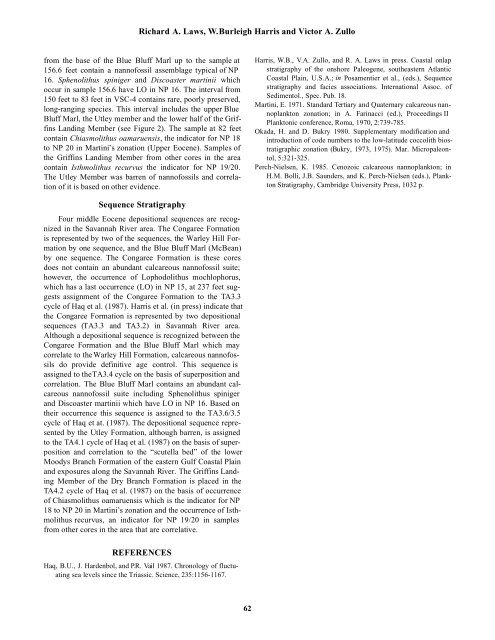Download Guidebook as .pdf (1.8 Mb) - Carolina Geological Society
Download Guidebook as .pdf (1.8 Mb) - Carolina Geological Society
Download Guidebook as .pdf (1.8 Mb) - Carolina Geological Society
Create successful ePaper yourself
Turn your PDF publications into a flip-book with our unique Google optimized e-Paper software.
Richard A. Laws, W. Burleigh Harris and Victor A. Zullo<br />
from the b<strong>as</strong>e of the Blue Bluff Marl up to the sample at<br />
156.6 feet contain a nannofossil <strong>as</strong>semblage typical of NP<br />
16. Sphenolithus spiniger and Disco<strong>as</strong>ter martinii which<br />
occur in sample 156.6 have LO in NP 16. The interval from<br />
150 feet to 83 feet in VSC-4 contains rare, poorly preserved,<br />
long-ranging species. This interval includes the upper Blue<br />
Bluff Marl, the Utley member and the lower half of the Griffins<br />
Landing Member (see Figure 2). The sample at 82 feet<br />
contain Chi<strong>as</strong>molithus oamaruensis, the indicator for NP 18<br />
to NP 20 in Martini’s zonation (Upper Eocene). Samples of<br />
the Griffins Landing Member from other cores in the area<br />
contain Isthmolithus recurvus the indicator for NP 19/20.<br />
The Utley Member w<strong>as</strong> barren of nannofossils and correlation<br />
of it is b<strong>as</strong>ed on other evidence.<br />
Harris, W.B., V.A. Zullo, and R. A. Laws in press. Co<strong>as</strong>tal onlap<br />
stratigraphy of the onshore Paleogene, southe<strong>as</strong>tern Atlantic<br />
Co<strong>as</strong>tal Plain, U.S.A.; in Posamentier et al., (eds.), Sequence<br />
stratigraphy and facies <strong>as</strong>sociations. International Assoc. of<br />
Sedimentol., Spec. Pub. 18.<br />
Martini, E. 1971. Standard Tertiary and Quaternary calcareous nannoplankton<br />
zonation; in A. Farinacci (ed.), Proceedings II<br />
Planktonic conference, Roma, 1970, 2:739-785.<br />
Okada, H. and D. Bukry 1980. Supplementary modification and<br />
introduction of code numbers to the low-latitude coccolith biostratigraphic<br />
zonation (Bukry, 1973, 1975). Mar. Micropaleontol,<br />
5:321-325.<br />
Perch-Nielsen, K. 1985. Cenozoic calcareous nannoplankton; in<br />
H.M. Bolli, J.B. Saunders, and K. Perch-Nielsen (eds.), Plankton<br />
Stratigraphy, Cambridge University Press, 1032 p.<br />
Sequence Stratigraphy<br />
Four middle Eocene depositional sequences are recognized<br />
in the Savannah River area. The Congaree Formation<br />
is represented by two of the sequences, the Warley Hill Formation<br />
by one sequence, and the Blue Bluff Marl (McBean)<br />
by one sequence. The Congaree Formation is these cores<br />
does not contain an abundant calcareous nannofossil suite;<br />
however, the occurrence of Lophodolithus mochlophorus,<br />
which h<strong>as</strong> a l<strong>as</strong>t occurrence (LO) in NP 15, at 237 feet suggests<br />
<strong>as</strong>signment of the Congaree Formation to the TA3.3<br />
cycle of Haq et al. (1987). Harris et al. (in press) indicate that<br />
the Congaree Formation is represented by two depositional<br />
sequences (TA3.3 and TA3.2) in Savannah River area.<br />
Although a depositional sequence is recognized between the<br />
Congaree Formation and the Blue Bluff Marl which may<br />
correlate to the Warley Hill Formation, calcareous nannofossils<br />
do provide definitive age control. This sequence is<br />
<strong>as</strong>signed to the TA3.4 cycle on the b<strong>as</strong>is of superposition and<br />
correlation. The Blue Bluff Marl contains an abundant calcareous<br />
nannofossil suite including Sphenolithus spiniger<br />
and Disco<strong>as</strong>ter martinii which have LO in NP 16. B<strong>as</strong>ed on<br />
their occurrence this sequence is <strong>as</strong>signed to the TA3.6/3.5<br />
cycle of Haq et at. (1987). The depositional sequence represented<br />
by the Utley Formation, although barren, is <strong>as</strong>signed<br />
to the TA4.1 cycle of Haq et al. (1987) on the b<strong>as</strong>is of superposition<br />
and correlation to the “scutella bed” of the lower<br />
Moodys Branch Formation of the e<strong>as</strong>tern Gulf Co<strong>as</strong>tal Plain<br />
and exposures along the Savannah River. The Griffins Landing<br />
Member of the Dry Branch Formation is placed in the<br />
TA4.2 cycle of Haq et al. (1987) on the b<strong>as</strong>is of occurrence<br />
of Chi<strong>as</strong>molithus oamaruensis which is the indicator for NP<br />
18 to NP 20 in Martini’s zonation and the occurrence of Isthmolithus<br />
recurvus, an indicator for NP 19/20 in samples<br />
from other cores in the area that are correlative.<br />
REFERENCES<br />
Haq, B.U., J. Hardenbol, and P.R. Vail 1987. Chronology of fluctuating<br />
sea levels since the Tri<strong>as</strong>sic. Science, 235:1156-1167.<br />
62













